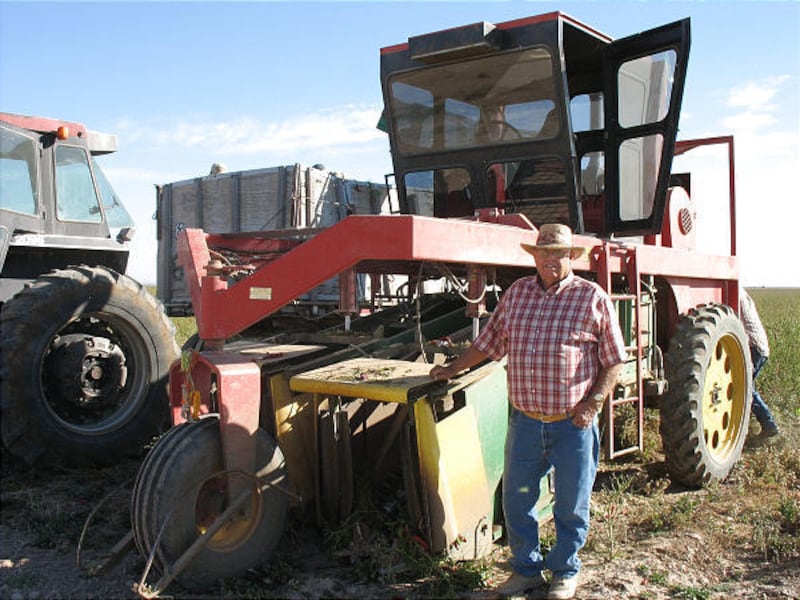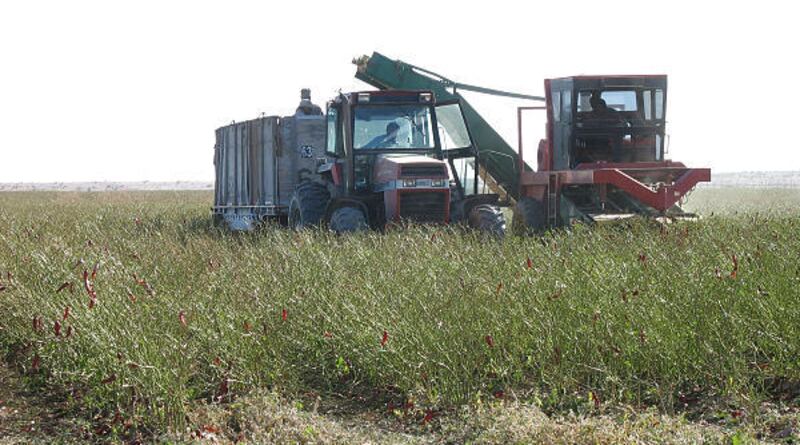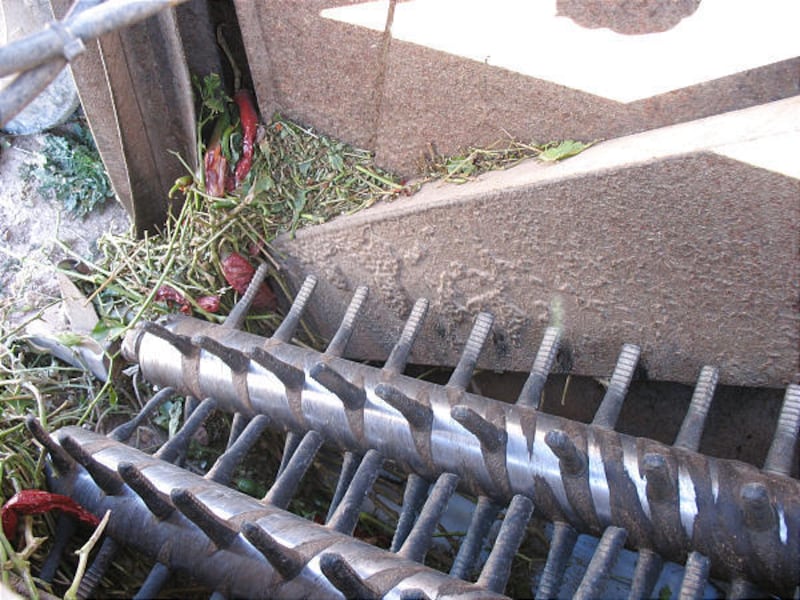LAKE ARTHUR, N.M. — A handful of farm laborers are busy at work on a warm day in mid-November, helping harvest 140 acres of Cecil Conklin's red chili crop. But at this southeastern New Mexico farm, the workers aren't stooped over hand-picking the peppers — they're driving Conklin's mechanical chili harvester as it plows through row after row of chili plants, methodically pulling off the peppers.
"The machine harvests about seven acres a day," said Conklin, one of the first farmers in New Mexico to make the switch to mechanical harvesting more than a decade ago. "That's about the same acreage that it took 40-50 workers to pick each day before we had the machine."
Mechanization "was forced on us — we couldn't find the labor. Now, chili definitely has to be mechanically harvested in order for farmers to make money," he said.
Increased market pressure from foreign chili imports, declining prices and lack of labor have made it tough for chili farmers to thrive. Using machines to harvest the state's signature crop is the only way the $400 million chili industry can stay competitive, said Terry Crawford, professor of agriculture business and economics at New Mexico State University in Las Cruces.
"Time is critical. New Mexico has no more than five years to get competitive. People in the industry need to see the light at the end of the tunnel to stick with it and not say, 'Gee, I'll start growing something else,"' Crawford said. "We have to become more efficient and cut labor costs significantly."
In New Mexico, more than 80 percent of the red chili crop is mechanically harvested, mainly in the southeastern part of the state. The harvest method also is being used increasingly by red chili growers in west Texas and southeast Arizona.
Stephanie Walker, vegetable specialist with NMSU's Cooperative Extension Service, said many chili farmers in eastern New Mexico found the transition to mechanical harvesting a little easier than those in the Rio Grande Valley corridor because they could rely on their knowledge from growing other mechanically harvested crops.
"Many of those farmers previously grew cotton, and they knew how to machine-harvest a crop. They used that expertise to make the chili harvest work, and they already knew how to harvest without large pools of labor," Walker said.
Foreign competition also is driving the change to mechanical harvesting, as farmers try desperately to compete with chili importers — such as China, India and Peru — that pay significantly lower wages.
"Here in the U.S., we pay an estimated $50 to $60 a day or better. Compare that to China, where workers are paid around $2 to $3 a day," Crawford said. "We're still in the early stages, but our hope is that mechanical harvesting can cut labor costs in half."
But switching over to mechanical harvesting is not cheap initially. Conklin said he paid $100,000 for his machine, but nowadays they can cost twice that amount.
The most common types of mechanical chili harvesters strip peppers from the plants and drop them onto a conveyor belt, which then transports the peppers to a holding container.
In the process, the unwanted parts of the plant known as trash, such as leaves and branches, are gathered along with the chili peppers. The pods must be separated from the trash either at the farm or at a processing plant before the chili crop can be used.
After Conklin's harvester fills a holding container, the semi trailer is driven to Riggs and Sons chili processing company in nearby Artesia, where the chili is cleaned and dehydrated.
Just as farmers are making investments to begin mechanical harvesting, processors have had to make similar expenditures to keep up with the changes in harvesting methods.
About 75 to 80 percent of chili that arrives from New Mexico, Texas, Arizona and northern Mexico for dehydration and oleoresin extraction at Rezolex Ltd. Co. processing plant is machine harvested, said Lou Biad, who operates the family owned business with headquarters in Radium Springs.
Oleoresin, derived from paprika peppers, is a natural red food coloring used in food products.
Biad said the 50-year-old company has gradually invested tens of thousands of dollars to accommodate mechanically harvested crops. Without the harvest method, the company would have a hard time meeting its supply needs.
"Mechanical harvesting is here — it's just not perfected. We're in the Model T stage, but with time and money and expertise, we could make it a Mercedes Benz," said Biad, who also serves as secretary of the New Mexico Chile Association and has lobbied for additional funding for the chili industry.
He said researchers need to develop new chili varieties that lend themselves to mechanized harvesting and machines to clean the trash from machine harvested chili.
Walker said she and other researchers are working to create chili varieties where the peppers are not so loose they fall to the ground or so tight that it's hard to get them off mechanically.
One downside of mechanical harvesting is a reduced crop yield. Hand pickers can grab chili not only on the actual plants, but also the peppers that have fallen to the ground.
Conklin said yield loss is linked to the variety grown. This year he experienced a 10 percent yield reduction of his Gilroy 648 chili crop, compared to last year when he grew a different variety and lost 20 percent.
Also, farms using mechanical harvesting only get one harvest a season, whereas hand-picked crops can have 2 or 3 picks because the plants aren't stripped of leaves and can produce more peppers, Crawford said.
In an effort to get New Mexico's entire chili crop mechanized, Walker and other experts are currently conducting tests to create a green chili pepper variety that can withstand mechanical abuse.
By the time red chili is harvested in early and late December, the pods are partially dried and leathery. Because green chili pods are immature and more delicate, the challenge lies in developing a harvester that does minimal damage to the pepper pod, Crawford said.
"The second issue with green is when you hand harvest, the picker removes the stem off the fruit. When you mechanically harvest, the stem comes with it. They're researching and creating a chili destemmer at NMSU that picks with the least amount of damage," he said.
New Mexico could see some mechanically harvested green chili by next year, he said.
Some jobs related to the chili harvest are still done by hand, even for farmers who mechanically harvest. Mechanical crop thinners have hit the market recently, but most farmers, including Conklin, still pay laborers to thin down overgrown crops in June.
Despite advancements in harvest methods to stay competitive, chili remains a difficult crop to grow. Conklin said in spite of his best efforts, there was little he could do this year to combat bacterial leafspot, a plant disease that caused his chili plant to lose leaves and produce less peppers.
Crawford said it sometimes seems as though chili is an unwilling participant in its success. The temperamental plant can get viruses, insects, wind damage and too much rain or water leads to a fungus or other diseases, he said.
The issue of labor costs and mechanization "has to be solved or the other problems are moot," Crawford said. "If you can't pick it, don't worry about if you can't sell it. It won't do you any good."



